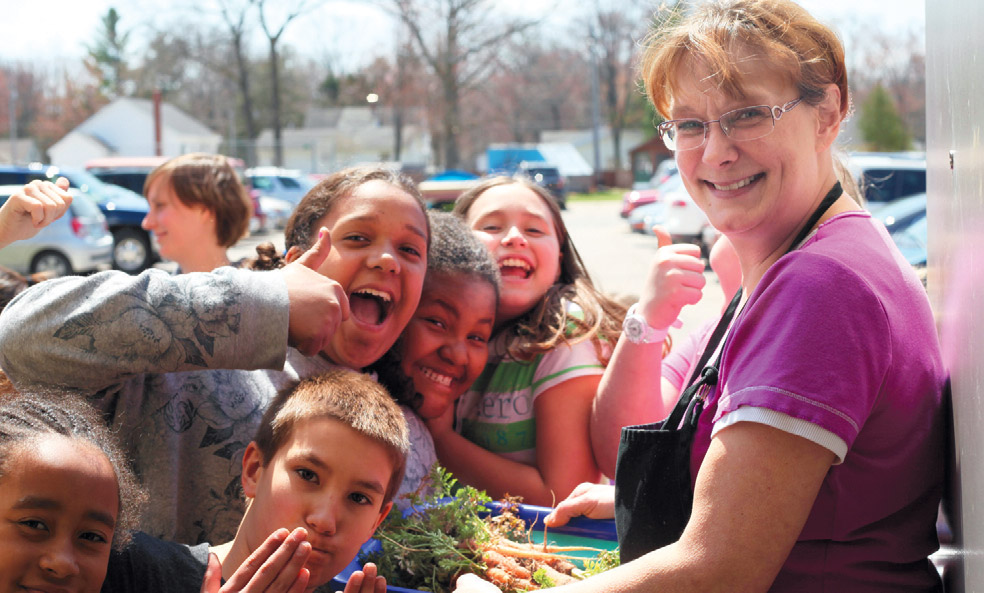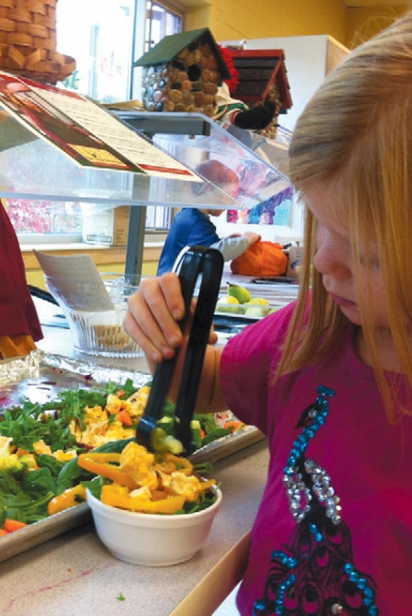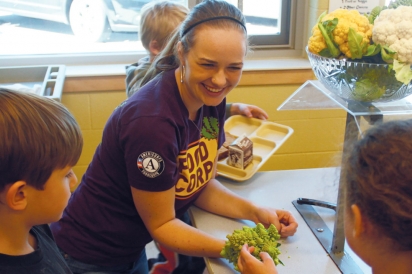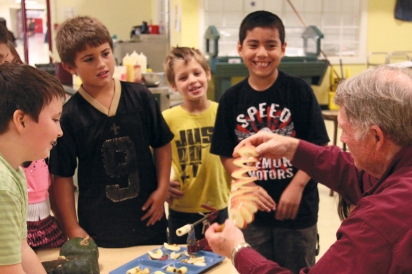What Our Kids Eat: Setting a Better Table at Michigan Schools
Why do we ask for so little when we need so much?
—Alice Waters, Traverse City, September 2017
Trite as the saying is, I do believe we are what we eat, and that what we eat builds our bodies and minds. I pay attention to what I prepare in my own home, and to what is available to my children at school. I’ve read the articles presenting links between a balanced, quality diet and a child’s mental acuity and physical energy, and I’ve listened to the recent NPR report on food scarcity’s effect on children and their test scores.
Clearly, healthy and nourished children sidestep the obesity epidemic, sleep better and have fewer behavior issues.
Thus, when my children described their school offerings in less than glowing terms, I decided to learn more, and found that I had opened a window into the many angles of a complex, evolving and, happily, improving situation. Let me share with you what I’ve learned and introduce you to a few of the players in Northern Michigan’s farm-to-school movement and the developing relationship between our local farmers and schools, to the enrichment of our local economy.
First a bit of history: The National School Lunch Act was passed in 1946. It quickly connected with the Charter of 1933 (Commodity Credit Corporation) whereby the federal government helped farmers by purchasing excess crops. These became the basis for low-cost “commodity” foods distributed and made available to institutions. Public schools were given priority in purchasing subsidized commodities such as flour (50 pounds for a dollar in the 1980s), butter, carrots, potatoes, rice, beans, cornmeal, eggs and chicken (originally cutup whole chickens—until it was determined that all chicken was to be transformed into easy-to-use, single-service patties, nuggets and strips, etc.).
As time passed, a whole slew of canned and processed options such as peanut butter, tomato paste and vegetable shortening became available. Today, pre-portioned, easily served processed food has become the norm for many.
Martha Ryan, now chef-owner of the farm-to- table restaurant Martha’s Leelanau Table, in Suttons Bay, was for 20 years the food service director for Leland Public School. Martha took on the role in 1982 because she felt adamant that the school shouldn’t, due to budget constraints, contract out food service to a frozen foods company offering options such as hot pockets and pizzas. She felt it was important to continue cooking on site and from scratch. She managed to do so within strict budget limitations, making do with a rudimentary kitchen and creatively incorporating government commodities. She did her part to maintain nutritious and tasty meal options for Leland during her tenure there.
However, she says, the trend during the two decades she managed the cafeteria was “to make school lunches ‘as good as’ fast food, instead of reaching further to real food. I think that is the big curve in the road that school food took: trying to make it competitive with fast food.”
Can we blame the powers that be for trying to adapt to the times and try to render school meals attractive to picky kids? Food service professionals wanted to avoid food waste and keep costs down, and these goals have always motivated the trends in the school lunch menus.
Tom Freitas, food service director for Traverse City Area Public Schools (TCAPS), tells me his budget is approximately $1.30 per meal served (not per student, not per day—so note that snow days can seriously impact the budget). Since 2010 he has been implementing the new nutrition standards, which added 10 cents to the cost of preparing every school lunch and 27 cents for every breakfast. To help schools meet those rules, Congress provided school meal programs six additional cents for each lunch (and no additional funds for breakfast), once the school could prove it was compliant. These new rules required 51 percent whole grains; limits on calories, sodium, sugar and fat; and servings of fruits and vegetables with every lunch, specifying portion sizes and daily and weekly offerings of legumes, dark green and red or orange vegetables.
Into this complex terrain of limited budgets and complex new regulations comes the creativity and passion of a few local champions, in particular, Diane Conners, senior policy specialist at Groundwork Center for Resilient Communities, based in Traverse City. She took on this issue, studying it from many angles over many years, cultivating relationships across the spectrum and putting not one but an assortment of steps into place.
Top of this list is the 10 Cents a Meal program. 2017 marks its second year and expansion to $375,000 (from an original $250,000) in state funds to be distributed as matching grants for the purchase of local fruits and vegetables. The program now runs in selected schools in 32 grant-winning districts in three regions.
Diane elaborates on the birth of this idea: “Even though we had all this interest, you might reach a ceiling of how much a school might spend. It could have nothing to do with the cost of food. Food service has to pay for heat and electric, for labor costs, whether you have a snow day or not. Revenue comes from the number of meals provided. That’s where the idea of 10 Cents a Meal came in.”
10 Cents a Meal encourages schools to purchase fruits and vegetables locally, stretching the school’s budget for these items and effectively doubling the money put back into the local economy. Not only does it improve the quality and choices available to the schools, but local farmers, distributors and the economy as a whole are benefiting, all the while exposing the next generation to the importance of farmers and the pleasures of eating local.
10 Cents a Meal is one step, but to improve its effectiveness, others are necessary. Diane tells me that she has relied on the “3 Cs” to aid in conceiving and realizing these steps:
Cafeteria: matching food service directors and farmers, expanding salad bar options.
Classroom: FoodCorps interns in the schools—teaching classes, building vegetable gardens with the students, leading tastings and, over time, designing lesson plans to fit into teachers’ curriculums including math skills, reading skills, teamwork and much more.
Community: connecting the local economy and bringing on partners including food distributor Cherry Capital Foods and Munson Healthcare.
Nic Welty of 9 Bean Rows fits into all three Cs. As a local vegetable farmer, he’s focused on schools as a market for his vegetables. Responding to the schools’ needs, he has brought ten colleagues into the Mi Farm Co-op and created an easy-to-use web-based ordering system, aimed to offer a consistent selection of cleaned and prepped vegetables along with delivery service.
With the assistance of the team at Groundwork Center, Mi Farm Co-op obtained a grant to set up a mid-scale vegetable cleaning, chopping and packaging system. Nic has visited classrooms to share his experiences and fresh produce with kids of all ages. He says, “I have found that the true impact of the results will only be a complete and thorough revolution of our farm-to-school system if everyone involved actually wants complete, meaningful change.”
To that end, he stressed the importance of parental involvement and communication with the school board, teachers and school administration. Perhaps, he suggested, though the official school meals budget is set, they might find some funds somewhere if the demand is large and vocal enough.
On a larger scale, Michigan food distributor Cherry Capital Foods (CCF) has built up its network and connections to get local produce to schools throughout the state, working with the demands of price point and regularity. Heather Ratliff, the institutional rep at CCF, loves letting her clients know about new options, such as multi-colored carrots or watermelon radishes that can be added to a salad bar.
Heather is particularly pleased that the whole animal program at CCF has permitted her to get quality chicken drumsticks out at the schools’ required price point, and has delivered quite a few to Interlochen Academy among others. She’s seen first-hand the difference 10 Cents a Meal has made in the ability of public schools to purchase locally grown produce and is eager for its reach to expand, opening new markets for local farmers and vitalizing the local economy.
Meghan McDermott, food and farming director at Groundwork Center, arrived first as a FoodCorps intern, bringing vegetable gardening and fruit and vegetable tasting experiences into the classrooms. She says that part of why she wanted to come to our region is that Northern Michigan has all the key players—local farmers, grouped distributorship and schools eager to participate—making it an ideal spot for this movement to take off.
In the classrooms, Meghan observed kids eager to learn and teachers excited by the possibilities. She played games such as “Taste it, Like it, Love it,” with broccoli romanesco. “It looks like an alien spacecraft!” said one child. She built gardens, designed vegetable beds and more, becoming such a popular presence at the school that she had classes back to back with nary a moment’s break.
It soon became clear to Meghan that though one person like her in the classroom can make a difference, it is imperative to put tools directly into teachers’ hands so they can integrate food and farming knowledge into their curriculum. As time is short in an academic year, Meghan and Groundwork Center have conceived a number of lesson plans that include math and logic problems, spatial orientation and more, adapted by grade levels, and easily accessed through the TBAISD web site. As the saying might go: “Give children a delicious, local vegetable and feed them well at one meal; teach them to design a garden, plant the seeds and tend them, and they will eat well for a lifetime.”
Lynn Brach, food service director and chef at the Leelanau School, a private school in Glen Arbor, is a beacon for how a great food program can be run. She is serving 90–95 percent food from scratch three times a day, plus snacks. Taking over the cafeteria kitchen five years ago, she’s implemented numerous changes over time, lowering costs, eliminating waste and improving quality. She relies heavily on Mi Farm Co-op and CCF for most of her ingredients, occasionally purchasing apples or blueberries directly from local farmers.
Taking the time to observe the eating habits of the student body and faculty helped her to carefully manage portions, as well as offering salad and sandwich bars as alternatives to the hot meal. To keep things interesting, she has introduced International Wednesdays where she might offer a Swedish or Somali hot meal option, including written explanations and learning materials. Where possible, she has collaborated with history teachers to prepare meals from different cultures and periods, bringing history to life in the classroom.
Working at a private school, her budget per student is higher than that of a public school, but she doesn’t have access to federally subsidized commodities. She wasn’t able to share all the numbers here, but it could be an interesting study to view her budget and expenses side by side with those of a public school of an equivalent size. Is it apples to oranges? Or might one learn from the other?
Going forward, what if 10 Cents a Meal were expanded to the whole state? And to every student? The state budget for this would be in the realm of $14 million, which might seem like a lot, but is it really? Imagine the effect on local economies, which would get double the funds since they come in with matching grants.
As food activist and chef Alice Waters stressed during her visit to Traverse City this fall, children are our future, and our public school system is the most democratic venue for reaching the entire population. Once, we had Home Economics classes that taught students how to roast a chicken, bake a cake, sew on a button, hem a pair of pants… What about updating the concept and integrating “life lessons” into our public schools? Imagine the class: Making a Salad from Scratch. Start with designing the vegetable garden, calculating spatial needs, quantities (math) and biological diversity (natural sciences), move on to tending and nurturing the plants, then harvest, clean, portion out by weight or volume (math skills) and finish by preparing a simple vinaigrette, learning the basics of a water and oil emulsion affected by kinetic energy (physics), serve, taste, keeping a journal all the while (English writing class), with an end-of-year essay to express the experience.
Excited by these possibilities and more, Diane says, “Others can observe how it works here, and learn, and then they can apply for the funds [from 10 Cents a Meal] and implement them in a focused and functional way. The regions can all be learning, overlapping. Growing it exponentially is a smart way to grow. We need to get to that tipping point where we have so many people in the state aware of the positive impact of growing the local economy while getting quality local food to the kids. Healthy food equals a healthy economy. And, in the meantime, real, true relationships are being built throughout the state.”
What might have been a dream a few years back is now becoming reality. But we all need to believe really strongly and get involved. Not having fairy dust to sprinkle on our heads, we must communicate with our local school boards and state legislators. Acknowledge that our schools are doing their very best within the means they have, but that our children deserve better than what they’re currently getting. Urging our politicians to increase the funds available for school meals, and stressing the importance of these experiences and options for our children is our responsibility. Changes are made when opinions are expressed and many choose to act.
Then, perhaps, another child will grab his mother’s hand and pull her toward the farmer’s stand at the market, pointing to the parsnips, urging, “Mom, please buy these! They’re really good. I had them at school.” And, just maybe, that child will tell his mother all about the farmer’s visit to the school, and how cool that was.










